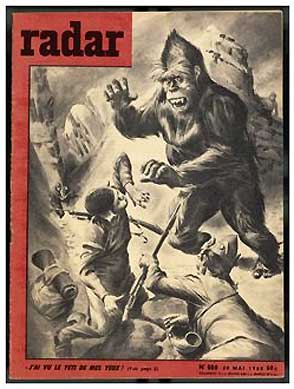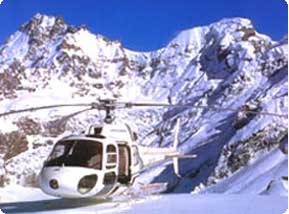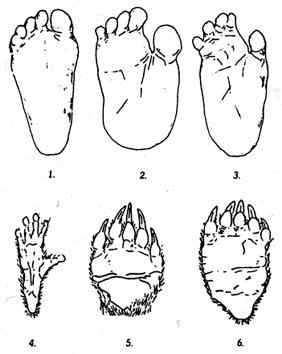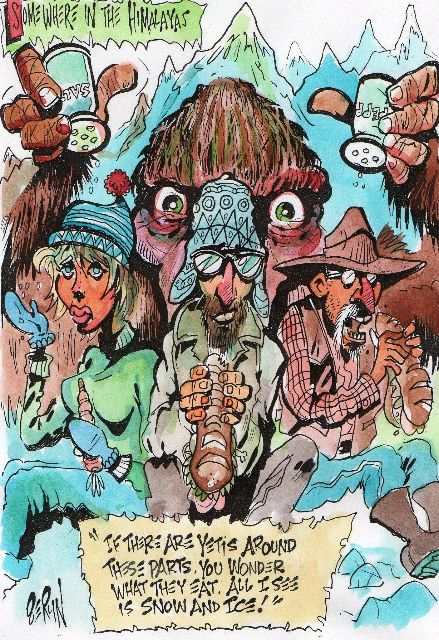Near Death On Yeti Expedition
Posted by: Loren Coleman on February 4th, 2009

The recent return of the first expedition searching for Yeti in 2009 has come back with a few frightening stories. The hunt was supported by MonsterQuest, who filmed an episode of their Season Three during the investigative journey.
Senior producer Will Yates just told me that the team found themselves, indeed, on “a dangerous expedition out in Nepal. The trekking was much more difficult than they anticipated and at one point a crew member nearly slipped to his death. At the end of the expedition helicopters had to do an extraction off the mountain.”

Team member Adam Davies (above), author of Extreme Expeditions, concurrently makes this report, via a new email to me:
I’m recovered from my Nepal trip. Here is an update on the Yeti expedition.
I think the Nepal expedition will prove to be the most textured and interesting MQ to date, for viewers. Not just because of evidence gathered, but also because of the dangers the team had to face.
The Himalayas in winter are not to be taken lightly. In addition, the team ventured to one of the remotest areas on earth.

Even given the use of helicopters, we still had to trek for days afterwards to reach our final destination. In pursuit of evidence, myself and the crew, really did risk our lives on top of the mountains, which were both terrible and beautiful.


As previously noted, the Japanese expedition photo of the “Yeti” footprint is on the left, and a human footprint, for comparison, is on the right.
Adam continues,
On a cryptozoological note, one very exciting point is that the prints found by Mr.Yagihara’s team are definitely NOT a Langur monkey. Having travelled to the area (and you will hopefully see this explained in the television episode) there is no way a monkey would have been at this location. Thus, as far as I’m concerned, the previous footprints found remain “unidentifiable primate.”
The evidence is still being analysed.
All I can say at this stage is that I absolutely loved making the show, and it was very, very hard work. Luckily, I’m minus only one toenail, (rather than any other body parts) and that should grow back soon!!!
Cryptomundo was happy to receive word that the team members made it back, safe and sound, and we look forward to this program about the Abominable Snowmen.
Season Three of “MonsterQuest” kicks off with its season premiere today, Wednesday, February 4th at 8 pm Eastern/9 pm Central. Their show on Yeti evidence will be broadcast at a later date.

Art by Charles Berlin.
About Loren Coleman
Loren Coleman is one of the world’s leading cryptozoologists, some say “the” leading living cryptozoologist. Certainly, he is acknowledged as the current living American researcher and writer who has most popularized cryptozoology in the late 20th and early 21st centuries.
Starting his fieldwork and investigations in 1960, after traveling and trekking extensively in pursuit of cryptozoological mysteries, Coleman began writing to share his experiences in 1969. An honorary member of Ivan T. Sanderson’s Society for the Investigation of the Unexplained in the 1970s, Coleman has been bestowed with similar honorary memberships of the North Idaho College Cryptozoology Club in 1983, and in subsequent years, that of the British Columbia Scientific Cryptozoology Club, CryptoSafari International, and other international organizations. He was also a Life Member and Benefactor of the International Society of Cryptozoology (now-defunct).
Loren Coleman’s daily blog, as a member of the Cryptomundo Team, served as an ongoing avenue of communication for the ever-growing body of cryptozoo news from 2005 through 2013. He returned as an infrequent contributor beginning Halloween week of 2015.
Coleman is the founder in 2003, and current director of the International Cryptozoology Museum in Portland, Maine.










Big TV crew. Helichopper evacuations. Lots of people.
And they’re back. ALREADY.
This, obviously, won’t cut it. If I were looking for confirmation of a fox in a woodlot, this wouldn’t cut it. Sure, you’d see tracks, burrows maybe, and other sign. But remember: those don’t count here as anything but interesting curios. They sure aren’t proof.
This will take months of effort, minimum, by one or a few smart, dedicated, savvy observers (and they don’t have to be scientists; think Jane Goodall, think Dian Fossey), living out there, observing observing observing, and being ready for the discovery shots when they come.
Monster Quest is good for the TV ratings of hairy hominoids. But stuff like this won’t prove anything. There is an outside chance, at best, that something that comes back will get someone important interested. But that’s like playing the lottery, so cross fingers.
As much as MQ has disappointed in the past, I must take issue with your line of thinking DWA, especially considering the location. Sure Goodall and Fossy spent months studying and observing but they were not in subzero temps on top of precarious mountains trudging and climbing thru snow and ice. Not to mention the altitudes and lack of oxygen.
While I would agree that last seasons quick trips were not going to cut it, in this case it would have been very difficult to keep trudging thru those mountains for very long.
I give them credit for at least making an attempt.
raisinsofwrath:
Oh, I’m not complaining that somebody tried. I guess that confirming (provided they did) that the print wasn’t a langur print might be something. But with both the yeti and sasquatch, there is tons of evidence far more compelling than that, and science has just yawned at it so far.
Anyway, my understanding is that the zoologically-enlightened thought on the yeti (such as that is) has the main populations not in the snowy wastes but in the forested valleys, with excursions above being primarily to scavenge kills, possibly take the occasional weakened prey, and maybe even to bury food in snow for later use (something that known animals, including wolves and wolverines, do as well).
Given that people do live in that region year round, someone could make a go of it, although rotating teams (very small ones) might be a better solution.
I didn’t say it would be easy. But as we’ve all heard since childhood, too much noise, well, it scares the fish, as it were. Plus, you have to drop your line where the fish are, as it were.
DWA, once again I totally agree with you.
Large expeditions do not produce much evidence when looking for these creatures. Too much noise and scent for starters. Limit it to two or three people max. When out in the field, treat it as a hunter would. Scent proof clothing for starters. No film crew. A high pixel video camera is good enough.
Yea, Jane Goodall spent months at a time in the field. Not a week or two.
This said I do not mean to upset those who spend time searching for these creatures. I commend you. I think we need to use a different approach with a longer timeline which may produce more evidence.
DWA is right: minimize your intrusion into the environment and you’re likely to get better results. And I agree that if it’s up there, it’s at lower elevations. I don’t think it’s living on snowy talus slopes and glaciers. That may be a hollywood perception of the creature’s environs, but it simply can’t be sustainable. Of course, without having seen any footage or maps or photos of where they have been spending their time, I guess we can’t really specultate too much on the teams movements. And finally, it costs to keep these things on the ground for any length of time. Sadly, funds for cryptozoology – as Loren can no doubt confirm – are seldom forthcoming. The field needs an eccentric billionaire badly.
If the elevation is the reason for dismissing the footprints as monkeys then I would consider their judgement as being suspect because there are indeed some pretty good sized monkeys that are adapted to high altitude and able to endure the climate. The golden snub nosed-monkeys which inhabit that area can live in elevations almost 15 thousand feet above sealevel for extended periods of time. I heard some of the males can become pretty robust.
eireman:
I keep waiting for Ted Turner. Did he, what, die or something? This kind of thing isn’t Ted Turner-y? Where is that guy?
I was reading about the kouprey – the Indochinese wild ox that can make the sasquatch and yeti seem kinda done-that – this morning. One article had the following quote from a biologist: “”The animals are out here,” says one, “but they’ve been so overhunted that now it takes at least six weeks of constant, quiet field presence to actually see one.”
SIX WEEKS, at least, of CONSTANT and yep the man said QUIET presence, to see an animal we know about, and that many scientists are convinced is still out there.
You know who’s done that for the yeti and the sasquatch? Combined?
Patterson and Gimlin.
And look what they got!
I think it is great entertainment, and to think it is anymore than that would be a mistake of the viewer..
Well Done Monster Quest, it has brought some interest, and magic back to a generation that is becoming , well boring and bland.. Bring back more of this stuff, including the likes of “In Search Of” etc etc …
Random thoughts about other cryptids as an example are fine, in moderation, but continued hijacking of the threads to record stream of consciousness insights will not be tolerated over and over again.
The topics are mostly Yeti, television series, MonsterQuest, Snowman expeditions, and related subjects here folks.
Once in a blue moon, it’s okay to go wild and rant, but when it becomes the pattern from comment section to new comment section, sorry, I have to put the brakes on it.
Thank you!
Ok, Loren, just to stick to the main subject…
I’m glad everything went Ok eventually for the expedition. Although I do agree a smaller one would probably have been better. I wish Yates and the team succeess in their quest for proof of the Yeti. Say not the struggle naught availeth…:)
Well, remember that Jane Goodall and the guy studying the kouprey have the added luxury of knowing for a fact that their subjects exist. That’s a pretty important factor to getting the funding for something like that. Not only do we not know whether the Yeti is real or not, the evidence isn’t really substantial enough at this time for us to really even suppose it exists. It’s a wild card, and thus funding is not going to be as forthcoming. Heck, funding is hard to get even for studying known animals. Especially in this financial climate, good luck. Pretty much at this time, private funding is the only type I can see happening.
That’s right, *gasp* scientists don’t just get unlimited access to money for every little project they want to study.
So I’m glad that someone is putting money into these kinds of expeditions. Before animals like the gorilla and okapi were discovered, it pretty much went the same way. There wasn’t exactly a rush by the scientific community to throw money at them, it was some adventurous wild cards gathering interest through evidence. IF MQ finds something that is truly compelling, and subject it to peer review and rigorous scrutiny from all angles, it could mean more scientific interest, so this sort of expedition could eventually pave the way towards what everybody here wants.
Don’t expect it to be a fast process though. Most worthwhile things in science aren’t, and findings can be subjected to a harsh, almost Darwinian weeding out process. Many scientists go their entire careers without making any significant new finding that sticks. Science isn’t like Indiana Jones, and those articles you read in science magazines are condensed, watered down versions of usually years and years of hard work. It’s a long, arduous, some might even say boring (not for me) process, and this is no field for those looking for instant gratification or fast answers.
Short of finding a body, I won’t expect any miracle on the expedition, but it might turn up something useful I suppose.
DWA- You are correct about the Yeti likely staying in the lower elevations. It makes a lot of sense from a biological point of view.
Look at any mountain habitat and you will see that once you get past the tree line, you are starting to get into basically a “biological desert.” You can think of it as sort of like the middle of the ocean, where there is a lot of wide open space, but just not much there to support a permanent population of animals. It’s not really so much due to the cold temperature of the mountains as it is all of the food resources and biomass are at the lower elevations in places like the forested valleys you mentioned. It wouldn’t make a lot of sense for animals to hang out in the upper reaches of the mountain where there are no trees or plants, and therefore no other wildlife.
The Yeti would be a big creature, with definite large energy requirements, something it is not going to find over the tree line. Pretty much short forays, for perhaps the reasons you mention, is all I would expect. Animals follow the food, and there just isn’t any way up in the treeless, snow swept upper reaches of the mountains.
So the image of the Yeti living in the barren, wind swept, snowy peaks is a cool one, but not very biologically plausible.
I would say that almost certainly Yeti habitat would be in the lower elevation forested areas and that this is the best bet for someone searching for them.
I’d concur with what DWA and MM says about habitat and elevation but point out an interesting is somewhat paradoxical aspect to that. The ecosystem above treeline is not quite the desert that’s described, but then again the desert as percieved in our culture isn’t the wasteland as it’s been percieved for so long either. It offers lower densities but that includes densities of competitors. For an animal that adapted to a solitary lifestyle and to travel efficiently over mountain terrane, there is much to be had foodwise for and omnivore in the form of bird eggs, small mammals, and tuberous plants (severe conditions favor those that store a lot of their nutrition below ground). Further more, an animal that can travel up and down steep terrane as resources become available without the kind of predisposition that humans and most 4 legged grazers and browsers do, to stay on contour following trails, can find themselves moving from one ecosystem to another quite easily. What takes a backpacker hours to hike at a shallow incline can take only minutes for a bushwhaker that can negotiate the steepness.
And because very few humans live above treeline (perhaps an instinctual preferrence from our arboreal ancestry) if an unknown hominin were to make that a primary habitat it could go un detected in any regular way.
Mystery_man:
Agreed; we’re not going to get a multibillion-dollar yeti search going tomorrow.
When I first read Schaller suggesting that amateurs – not professionals – should go to game cameras to document the sasquatch, my first thought was: sellout! I thought you thought this was worthy of scientific attention! Then of course I realized he was just reflecting reality. Scientists are busy. Full time. (It’s called a JOB.) To ask the vast majority of them to go after a cryptid like they go after the things they already go after is to tell them to give up their job and take up a whole new career. How many will do that? Hey, you see me giving up my job for this? (You don’t even see me. Right.) Schaller was just suggesting a new tool to folks who were already interested, and while they didn’t have near enough time to do this, at least were obviously devoting some time to it. And he’s a very busy man; he was doing the field a great favor simply by addressing it in a positive way becoming a scientist.
So, sure, MonsterQuest might be performing a useful function here. What it should also be doing, however, is dealing strictly in scientific honesty. (Am I the only one who wrinkles his nose at the “Monster” thing?) I applaud, as others do here, anyone who gives this any time; they’re our only hope at present. But like Schaller, some of us have suggestions (and a scientist right here is backing us up 🙂 ) that we think are worth pursuing. Just because pulp fiction makes it a “snowman” doesn’t mean that’s where you have to look.
The only fly in the ointment might be the snow leopard, which does seem to be pretty much up there most of the time. But even the leopard moves up and down with the food. It is also highly specialized to hunt animals that occupy, to the limit, some of the very few niches for sizable critters that there are up there.
And remember: Jane Goodall wasn’t a scientist. She got into the trade pretty cheap. That’s what the search needs now.
But yes; it first needs professionals who can command the time, and the money, to think that is worth doing.
Dogu4- Of course I didn’t mean to imply that the desert is a barren wasteland, obviously desert ecosystems exist. I meant it in a metaphorical sense.
I also did not mean to say that above the tree line is completely devoid of life, at least to a point. Some organisms do survive to a certain extent above the tree line, but the high elevations and lack of vegetation make this environment one of the harshest on Earth. Many times, the animals that survive there are small animals and certain types of insects, often specially adapted for that lifestyle. They also tend to live fairly close to the tree line, (notice I said you are “starting” to get into the biological desert I described), but not in the elevations high above it, which are pretty much devoid of life. Also, the large mammals that live at higher elevations are predominantly found mostly in the higher forests within the tree line, or in the forested valleys, with animals like the yak and snow leopard being seen only occasionally above it.
The Yeti is a large animal, which entails large food requirements, and above the tree line is perhaps not the most suitable permanent habitat for it. I can’t really see a viable breeding population of animals this large persisting and flourishing permanently above the tree line. The greatest biomass is found lower. We can speculate all we want on the Yeti’s movements, but like other large animals in its habitat, it seems very plausible to me that the Yeti could be predominantly found at elevations below the tree line.
I tend to think that if there is a Yeti there, then it lurks at lower elevations below or very near the tree line, where food resources are plentiful, and perhaps crosses the more barren expanses perhaps to travel or in short forays.
Dogu4- Although I suppose there are enough indigenous cold adapted animals living in the Alpine zone right above the tree line that a Yeti could do Ok there. I suppose I should say that I am referring to the higher elevations above the tree line, the snowy wastelands that everyone imagines when they think of “Abomidable Snowmen.”
Dogu4- Even in the Alpine zone, such a large animal would probably be an omnivore like you said in order to meet its food requirements. There is a good range of vegetation there, but animal life in this area is sparse and as I said made up of smaller animals such as hares and marmots and such, with larger animals below the tree line. It is interesting to speculate on an animal as large as the Yeti adapting to take advantage of this ecosystem. Still, I think the forests at or below the tree line are a more likely place.
I might not have been specific enough in my comments about the snow leopard.
I definitely don’t think that mountaineers are gonna see one on the summit of Everest. Mystery_man’s comment about the region just above tree line is what I had in mind. If you’re not finding bharal and ibex, you’re not finding snow leopard.
And for my money. you’re not seeing yeti where you see snow leopard, most of the time. When it comes to predation, I see the yeti as being like other primates (than us, I guess) are in this regard: an opportunist, taking what comes its way. it may take elderly or disease-weakened ungulates, or score the occasional lucky ambush of an unwary animal. But it’s going smaller – with a substantial vegetable component – most of the time. (The mouse hare – a lower-elevation animal – is cited as a strong possibility for closest item to an animal staple for the yeti.)
Are we all really sure that the truth would make it to general broadcast? Could, maybe, there be forces working behind the scenes to prevent substantial proof of these creatures from being publicly announced?
When i think of a show linke MonsterQuest actually proving the existence of ‘Squatch or Yeti i get a mental image of the harbor in “Jaws” just after the ad goes in the paper for the reward: full of hundreds of semi-professional and amatuer hunters looking for glory and fame.
“What if..” the Georgia boys had *really* found one? Do any of us honestly want that? Let Monsteruest entertain, inform, and give exposure to the genre. But please don’t let it confirm anything, for the sake of any large cryptid mammals that still exist.